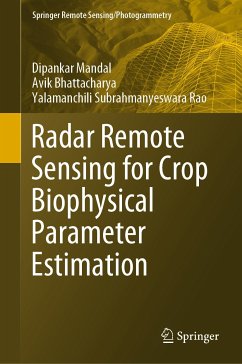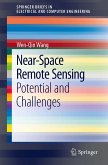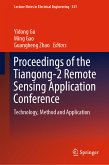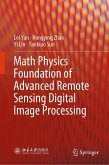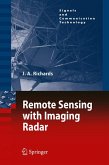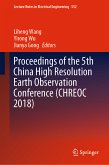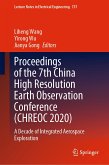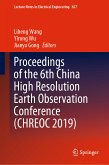Radar Remote Sensing for Crop Biophysical Parameter Estimation (eBook, PDF)


Alle Infos zum eBook verschenken

Radar Remote Sensing for Crop Biophysical Parameter Estimation (eBook, PDF)
- Format: PDF
- Merkliste
- Auf die Merkliste
- Bewerten Bewerten
- Teilen
- Produkt teilen
- Produkterinnerung
- Produkterinnerung

Hier können Sie sich einloggen

Bitte loggen Sie sich zunächst in Ihr Kundenkonto ein oder registrieren Sie sich bei bücher.de, um das eBook-Abo tolino select nutzen zu können.
This book presents a timely investigation of radar remote sensing observations for agricultural crop monitoring and advancements of research techniques and their applicability for crop biophysical parameter estimation. It introduces theoretical background of radar scattering from vegetation volume and semi-empirical modelling approaches that are the foundation for biophysical parameter inversion. The contents will help readers explore the state-of-the-art crop monitoring and biophysical parameter estimation using approaches radar remote sensing. It is useful guide for academicians, practitioners and policymakers.…mehr
- Geräte: PC
- ohne Kopierschutz
- eBook Hilfe
- Größe: 10.4MB
![Near-Space Remote Sensing (eBook, PDF) Near-Space Remote Sensing (eBook, PDF)]() Wen-Qin WangNear-Space Remote Sensing (eBook, PDF)40,95 €
Wen-Qin WangNear-Space Remote Sensing (eBook, PDF)40,95 €![Proceedings of the Tiangong-2 Remote Sensing Application Conference (eBook, PDF) Proceedings of the Tiangong-2 Remote Sensing Application Conference (eBook, PDF)]() Proceedings of the Tiangong-2 Remote Sensing Application Conference (eBook, PDF)113,95 €
Proceedings of the Tiangong-2 Remote Sensing Application Conference (eBook, PDF)113,95 €![Math Physics Foundation of Advanced Remote Sensing Digital Image Processing (eBook, PDF) Math Physics Foundation of Advanced Remote Sensing Digital Image Processing (eBook, PDF)]() Lei YanMath Physics Foundation of Advanced Remote Sensing Digital Image Processing (eBook, PDF)81,95 €
Lei YanMath Physics Foundation of Advanced Remote Sensing Digital Image Processing (eBook, PDF)81,95 €![Remote Sensing with Imaging Radar (eBook, PDF) Remote Sensing with Imaging Radar (eBook, PDF)]() John A. RichardsRemote Sensing with Imaging Radar (eBook, PDF)113,95 €
John A. RichardsRemote Sensing with Imaging Radar (eBook, PDF)113,95 €![Proceedings of the 5th China High Resolution Earth Observation Conference (CHREOC 2018) (eBook, PDF) Proceedings of the 5th China High Resolution Earth Observation Conference (CHREOC 2018) (eBook, PDF)]() Proceedings of the 5th China High Resolution Earth Observation Conference (CHREOC 2018) (eBook, PDF)113,95 €
Proceedings of the 5th China High Resolution Earth Observation Conference (CHREOC 2018) (eBook, PDF)113,95 €![Proceedings of the 7th China High Resolution Earth Observation Conference (CHREOC 2020) (eBook, PDF) Proceedings of the 7th China High Resolution Earth Observation Conference (CHREOC 2020) (eBook, PDF)]() Proceedings of the 7th China High Resolution Earth Observation Conference (CHREOC 2020) (eBook, PDF)169,95 €
Proceedings of the 7th China High Resolution Earth Observation Conference (CHREOC 2020) (eBook, PDF)169,95 €![Proceedings of the 6th China High Resolution Earth Observation Conference (CHREOC 2019) (eBook, PDF) Proceedings of the 6th China High Resolution Earth Observation Conference (CHREOC 2019) (eBook, PDF)]() Proceedings of the 6th China High Resolution Earth Observation Conference (CHREOC 2019) (eBook, PDF)113,95 €
Proceedings of the 6th China High Resolution Earth Observation Conference (CHREOC 2019) (eBook, PDF)113,95 €-
-
-
Dieser Download kann aus rechtlichen Gründen nur mit Rechnungsadresse in A, B, BG, CY, CZ, D, DK, EW, E, FIN, F, GR, HR, H, IRL, I, LT, L, LR, M, NL, PL, P, R, S, SLO, SK ausgeliefert werden.
- Produktdetails
- Verlag: Springer Nature Singapore
- Seitenzahl: 236
- Erscheinungstermin: 16. August 2021
- Englisch
- ISBN-13: 9789811644245
- Artikelnr.: 62442213
- Verlag: Springer Nature Singapore
- Seitenzahl: 236
- Erscheinungstermin: 16. August 2021
- Englisch
- ISBN-13: 9789811644245
- Artikelnr.: 62442213
- Herstellerkennzeichnung Die Herstellerinformationen sind derzeit nicht verfügbar.
Basic theory of radar polarimetry.
Vegetation models: Empirical and Theoretical approaches.
Evolution of Semi
empirical approach: Modeling and Inversion.
Biophysical parameter retrieval using full and dual
pol SAR data.
Biophysical parameter retrieval using compact
pol SAR data.
Radar vegetation indices for crop growth monitoring.
Summary and Conclusions.
Basic theory of radar polarimetry.
Vegetation models: Empirical and Theoretical approaches.
Evolution of Semi
empirical approach: Modeling and Inversion.
Biophysical parameter retrieval using full and dual
pol SAR data.
Biophysical parameter retrieval using compact
pol SAR data.
Radar vegetation indices for crop growth monitoring.
Summary and Conclusions.
